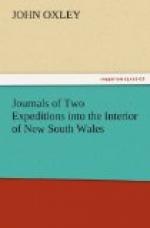October 3.—Soon after daylight, accompanied by the botanist, I returned to the peaked hill, leaving the horses with Mr. Evans to proceed to the north-east. Certainly a more beautiful and interesting view is not often seen. The spacious valley, through which the river flowed, extends along the coast from Smoaky Cape to the Three Brothers, and its width north of me was above eight miles, gradually narrowing to the base of Sea View Mount where we first entered it, and which bore west by north. Wide and extensive valleys stretched to the west-south-west, and south-south-west, under its base on either side, the hills in which were of moderate height, and of open forest land. To the north by east, though high land was seen at a distance of near sixty miles, the general face of the country was low with moderate and regular elevations, the highest lands being immediately behind the capes and projecting points into the sea. But the object that most interested me in this extensive survey was the appearance of the river: at a distance of seven or eight miles north-east of me, it opened into wide reaches extending to the sea, which it seemed after a winding course to enter nearly east, or in about the situation assigned by Captain Flinders to a lake across the entrance of which there appears to be a bar. The country on its banks, and within the limits before mentioned, appeared very brushy and low; the banks themselves seeming to be the highest ground. I conjectured that the river’s extending itself to such a considerable breadth, was probably caused by the tide-water; and I could not help entertaining the strongest hope from its appearance that it would prove navigable, whatever its entrance might be. To the north of the river, a few miles from it, appeared lagoons, or swamps, probably having some beach communication with the sea. Another large lake was also seen to the south-east, under the Three Brothers. Several other small patches I thought might possibly prove to be marshes between my station and the coast; the country in its immediate vicinity appearing too low to afford drainage. Descending the hill, I proceeded after the horses, passing for nearly three miles through a good open forest country; the timber large, with numerous casuarinae. At the entrance of a brush I met the horses returning, having been prevented from continuing their easterly course by a large tea-tree swamp, full of water. We therefore pursued a more northerly course, with the hope and intention of making the river near the wide reaches, which I had seen from the hill. From the forest land we immediately entered a thick brush, and after cutting our way for near two miles, the evening advancing, I thought it best to send back the horses to the forest land, where there was plenty of grass, and proceeded myself with some men to cut the road to the river; an object, which in about another mile we effected. We happened to make it near the spot wished for. The tide was going out,




